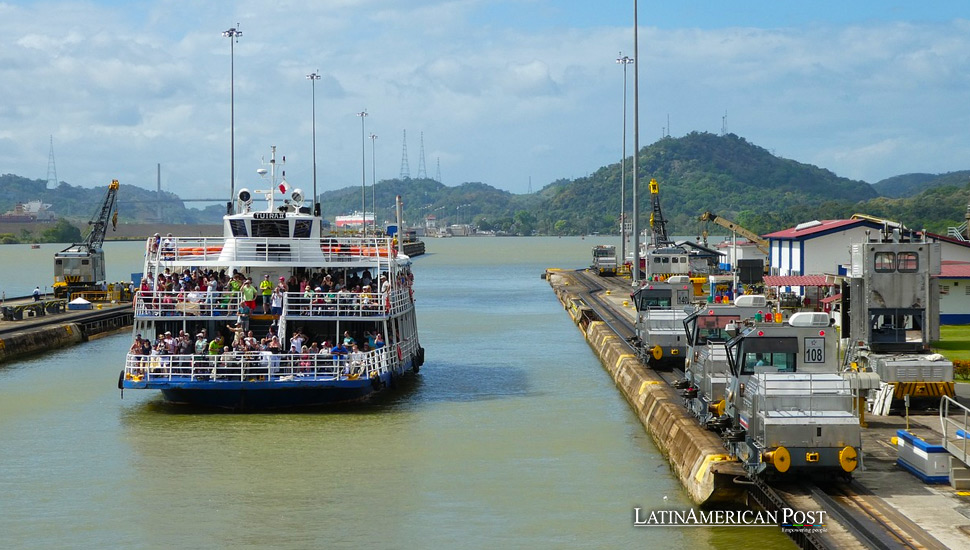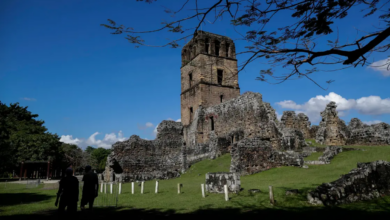The Thirst of Progress: Panama Canal’s Water Crisis and Latin America’s Environmental Warning

Amid dwindling rainfalls and rising challenges, the Panama Canal’s critical water shortage not only jeopardizes global trade but also serves as a stark reminder for Latin America of the urgent need for sustainable water management and climate resilience.
In the lush landscapes of Central America, the Panama Canal stands as a testament to human ingenuity and the interconnectedness of the global economy. However, this marvel of engineering is facing an unprecedented challenge that echoes across Latin America: a severe water shortage that threatens its operation and, by extension, the flow of international trade. The situation at Lake Gatún, the freshwater source vital for the canal’s locks, highlights a broader water scarcity crisis and climate vulnerability facing the region.
A Crisis Compounded by Climate
Nelson Guerra, the canal’s dedicated hydrologist, reveals a concerning drop in Lake Gatún’s water levels, now 81.20ft, five feet below expected norms. This shortage is more than a statistic; it represents the vulnerability of a waterway that supports $270bn worth of cargo annually. Seeing old tree stumps emerging from the lake’s surface, remnants of the canal’s creation, is a stark visual marker of the water crisis.
The canal’s reliance on rainwater has become its Achilles’ heel in the face of changing climate patterns. Last year’s drought, intensified by the El Niño phenomenon, marked the second driest year in the canal’s 110-year history. The implications of this scarcity extend beyond navigation, affecting the drinking water supply for half of Panama’s population, including the bustling metropolis of Panama City.
Global Trade at a Crossroads
The Panama Canal’s predicament has immediate repercussions for global commerce. With the canal’s capacity reduced, ships must carry less cargo and wait longer for passage, disrupting the efficiency of a route that accommodates 5% of the world’s maritime trade. This bottleneck has wide-reaching effects, from increased consumer costs to strained supply chains, highlighting the canal’s pivotal role in international logistics.
Latin America’s Environmental Crosshair
The water crisis at the Panama Canal is a microcosm of Latin America’s environmental challenges. The region, characterized by its vast biodiversity and natural resources, is increasingly grappling with the impacts of climate change, from deforestation in the Amazon to glacier retreat in the Andes. The canal’s struggle underscores the urgent need for comprehensive environmental policies and sustainable water management practices across the continent.
In response to the looming crisis, the Panama Canal Authority, under its first chief sustainability officer, Ilya Espino de Marotta, spearheads an ambitious $8.5bn sustainability plan. The initiative aims to ensure the canal’s longevity through water conservation measures, the construction of reservoirs, and the exploration of desalination to counteract increased salinity. These projects, while vital, face hurdles in approval and implementation, underscoring the complexities of adapting to a changing climate.
The Broader Implications for Latin America and Global Trade
The water shortage in the Panama Canal serves as a cautionary tale for Latin America, where water scarcity and climate vulnerability pose growing threats to development and stability. The crisis amplifies the call for regional collaboration to address environmental challenges and share resources and knowledge to foster resilience and sustainability. It also highlights the importance of international cooperation in supporting Latin America’s efforts to mitigate climate impacts and safeguard its natural heritage.
The disruption of the Panama Canal’s operations has broader implications for the global economy, underscoring the fragility of international trade routes in the face of environmental change. As companies and countries navigate the complexities of rerouting cargo and absorbing increased costs, the situation highlights the interconnectedness of global markets and the need for proactive climate adaptation strategies.
A Call to Action
The crisis facing the Panama Canal is a wake-up call for Latin America and the world. It emphasizes the urgency of addressing climate change and environmental degradation, not only as a matter of ecological preservation but also as a critical component of economic security and global cooperation. As the region looks to the future, the lessons learned from the Panama Canal’s water shortage could pave the way for innovative solutions and more substantial commitments to sustainability.
Also read: Panama’s Copa Airlines Navigates the Boeing 737 MAX9 Suspension
The Panama Canal’s water crisis is more than a challenge to maritime logistics; it reflects the broader environmental and climate issues confronting Latin America and the world. As the region rallies to address these pressing concerns, the resilience and innovation demonstrated by the Panama Canal Authority offer hope for a sustainable path forward. In the face of adversity, the canal’s plight reminds us of the indomitable human spirit and the collective action required to safeguard our planet for future generations. Through collaboration, investment in sustainable practices, and a steadfast commitment to environmental stewardship, Latin America can navigate the complexities of the 21st century, ensuring that its natural wonders, like the Panama Canal, continue to thrive amidst the challenges of a changing world.




